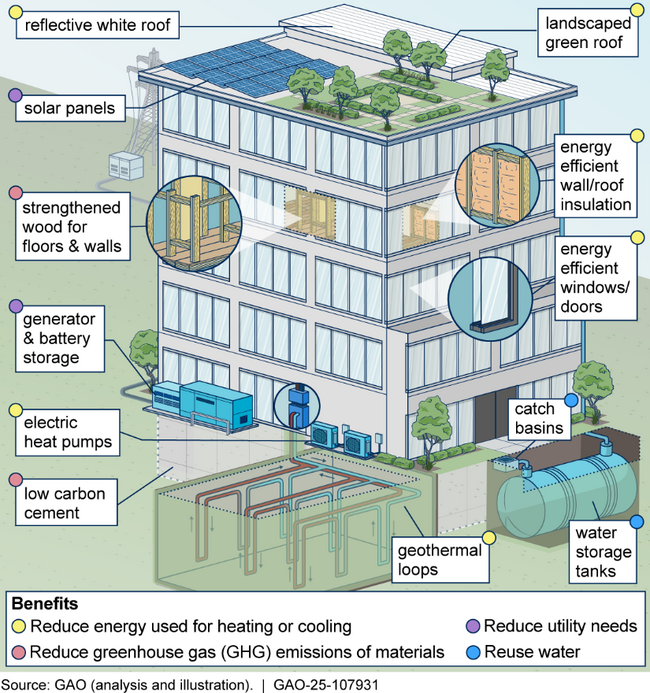Science & Tech Spotlight: Sustainable Building Technologies
Highlights
Why This Matters
There are over 130 million buildings in the U.S., and owners spend more than $370 billion annually on energy, the U.S. Department of Energy (DOE) reported in 2024. It also reported that buildings use 40 percent of the total energy used in the U.S. In 2022, buildings accounted for over 30 percent of greenhouse gas emissions, according to the U.S. Environmental Protection Agency. Sustainable building technologies may reduce energy use, costs, and emissions.
Key Takeaways
- Sustainable building technologies can deliver benefits but may raise construction costs.
- Savings over a building's life are hard to estimate, and initial owners may not recoup their higher up-front costs.
- Policymakers and industry have used funding incentives to develop some technologies.
The Technologies
What are they? Sustainable building technologies include solar panels, energy efficient windows, and low emission materials. They aim to reduce energy use, water use, and greenhouse gas emissions in construction and operations. They may be applied to new and existing buildings, both commercial and residential. They can lessen climate effects and improve resilience to severe weather, such as hurricanes and extreme heat events.
How do they work? Multiple sustainable building technologies are often combined in new or renovated buildings to maximize energy and water savings. For example, a building may combine energy from solar panels, automated heat and water controls, and windows that automatically adjust heat transmission at higher temperatures to reduce energy use. Catch basins can collect rainwater for building cooling and landscape needs, which reduces water usage, reduces costs, and controls potentially damaging storm runoff. Building owners’ decisions to install any technology are usually based on (1) estimates of initial costs and future savings over the time they plan to own the building or the building’s lifespan (e.g. 50 years), and (2) local building code requirements.
Further, owners may choose to reduce their associated CO2 emissions by using certain construction materials. For example, strengthened timber is now being used in some commercial construction projects as a low-CO2 alternative to reinforced concrete.
Figure 1. Examples of Sustainable Building Technologies in Use

How mature are they? Many sustainable technologies are mature and commercially available, such as solar panels. Other technologies are mature but not used widely. For example, in-ground geothermal loops use the ground’s temperature to heat or cool buildings, but they are not used much, in part due to high installation costs. Similarly, high costs have limited the use of “zero-energy buildings” which generate as much energy on-site as they use. A 2020 report suggested there were fewer than 200 such commercial buildings in the U.S. and Canada.
In recent years, government and industry have sought to develop technologies to achieve a zero–CO2 emissions building sector. For example, given that cement production contributes about 8 percent of global CO2 emissions, in 2023 DOE encouraged industry to accelerate the manufacture of low-CO2 cement. In 2024 DOE, with industry input, defined the criteria for a zero-emissions building.
Government and industry have also partnered to pilot sustainable building technologies such as more efficient solar panels, windows, insulation, and heating systems. Incentives, including federal, state and local grants and tax rebates, have subsidized some costs. Some manufacturers are working to quantify the CO2 content of their construction products, though independent estimates are limited.
Opportunities
- Reduce building owners’ costs. Use of renewable power sources and more energy-efficient construction materials can save energy and lower utility costs.
- Help address emissions. Use of low CO2 sustainable building materials can reduce the CO2 emissions in building construction and operations.
- Improve resilience. New and retrofitted buildings that use renewable power and energy storage can reduce use of the utility grid and help restore power after disasters. Other sustainable technologies can improve resilience during water shortages and extreme heat.
Challenges
- Initial costs and labor to maintain. The initial cost of buying and installing more sustainable building systems can be high, and different technical skills may be needed to operate and maintain those systems.
- Uncertain long-term rewards. Estimates of a building’s future cost savings and benefits are uncertain, and some future savings and benefits may not accrue to the building’s original ownership and investors.
- Local factors. The applicability of the technologies depends on local factors such as building codes, weather, site size, and availability of materials and skilled labor.
Policy Context and Questions
- Future policies may affect the use of sustainable building technologies.
- If the goal is to increase adoption, what funding incentives or building code changes might be needed?
- How could estimates of future savings and benefits of these technologies be improved to better inform owners and policymaking?
- What demonstration projects might government or industry pursue to further show building owners the potential benefits and drawbacks of these technologies?
Selected GAO Work
Federal Buildings: Capital Access and Open Markets Are Key Challenges Facing GSA’s Sustainability Efforts, GAO-23-105905.
Selected References
U.S. Department of Energy. Better Buildings. Leading the Way: Partnerships and Solutions. Washington, D.C.: Progress Report 2024.
U.K. Green Building Council, Building the Case for Net Zero: A feasibility study into the design, delivery, and cost of new net zero carbon buildings. September 2020
For more information, contact Brian Bothwell at (202) 512-6888 or bothwellb@gao.gov.
